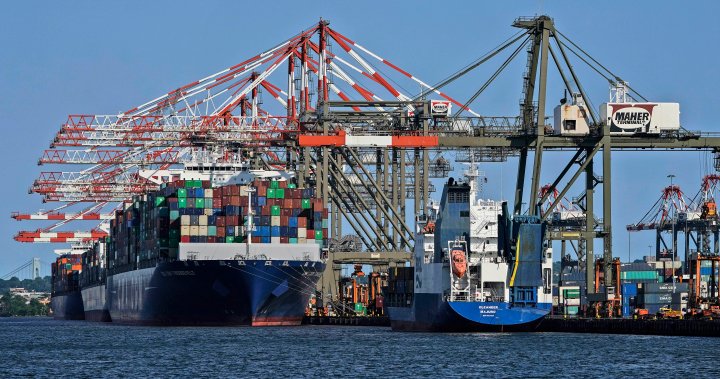Breaking News
A U.S. port strike looms, and it would be ‘devastating’ for supply chains – National

Following a nationwide rail shutdown in Canada, a potential strike at U.S. seaports on the East Coast and Gulf of Mexico is now looming, posing a threat to disrupt supply chains even further.
The International Longshoremen’s Association (ILA), which represents approximately 45,000 dockworkers at three dozen seaports from Texas to Maine, has issued a strike threat for Oct. 1 if a new contract agreement is not reached with the United States Maritime Alliance (USMX) of shipping companies.
Experts warn that a work stoppage at the ports could lead to significant cargo backlogs lasting weeks or even months, with implications extending beyond the U.S.
“An East Coast port strike would have a catastrophic impact on supply chains in North America,” said Fraser Johnson, a professor at Western University’s Ivey Business School specializing in supply chain management.
Many imports to Canada flow through American ports on the east coast, which have much higher capacity than the Port of Halifax and Port of Montreal, the primary Canadian shipping points on the Atlantic.
The Port of New York and New Jersey, the largest East Coast port, handles about US$300 billion worth of goods annually and processed 7.8 million 20-foot equivalent units (TEU) last year. In comparison, the Port of Montreal saw 1.5 million TEUs in 2023, and the Port of Halifax managed just over 546,000.
An economic study conducted by Martin Associates estimated the annual value of goods handled at the Port of Montreal to be $151.2 billion, while the Port of Halifax does not provide these dollar value calculations.
Both ports would struggle to accommodate even a fraction of the goods that typically pass through the U.S., in addition to their regular cargo traffic, according to Johnson.

What would the impact be?
A one-day shutdown of the eastern U.S. ports would have severe consequences, according to analysts at Sea-Intelligence, a shipping advisory firm based in Copenhagen. They estimated that it could take anywhere from four to six days to clear the backlog resulting from a one-day strike.

Get breaking National news
For news impacting Canada and around the world, sign up for breaking news alerts delivered directly to you when they happen.
The analysis predicted that a one-week strike in October would not be resolved until mid-November, and a two-week strike could delay ports from returning to normal operations until 2025.
The global shipping company Maersk, a member of USMX, provided similar estimates in an update on the U.S. market in early August, warning of “significant” delays if a strike occurs.
These potential backlogs coincide with the recent resumption of freight traffic following a four-day shutdown of Canada’s main railways. While trains have started moving again, Canadian National Railway Co. and Canadian Pacific Kansas City Ltd. have indicated that a full recovery will take several weeks.
After a 13-day strike by B.C.’s longshore workers in 2023, the Port of Vancouver reported that it took several months to clear the backlog, with delayed shipments and strained infrastructure struggling to return to normalcy.
The shipping industry has been grappling with various challenges worldwide, including an ongoing drought at the Panama Canal leading to reduced ship traffic, and attacks on container vessels in the Red Sea due to conflicts in the Middle East necessitating costly re-routings.

Amidst all these challenges, inflation has driven shipping and freight costs up since the COVID-19 pandemic, and workers are seeking to ensure their wages keep pace.
“These are not normal times,” Johnson remarked.
The National Retail Federation informed Reuters that retailers such as Walmart and Target are expediting goods into the U.S. to prepare for a potential strike and avoid shortages during the holiday shopping season.
The West Coast ports are already experiencing increased activity, which analysts attribute to uncertainty surrounding the East Coast labor dispute. This situation contrasts with last year when negotiations for western U.S. dockworkers’ contracts were challenging.
The International Longshore and Warehouse Union (ILWU) ultimately approved a new six-year contract with a 32% pay increase over that period, retroactive to 2022, and enhanced benefits. The ILA is now seeking a similar agreement.
ILWU International President Willie Adams expressed solidarity with the ILA in a letter to ILA President Harold Daggett earlier this month, which the east coast union made public.
Where are the negotiations at now?
Negotiations between the ILA and USMX stalled over the summer but are scheduled to resume in the weeks leading up to the strike deadline. Both parties have requested federal mediation, and the union has planned wage scale meetings for early September.
The ILA has criticized the threat automation poses to port jobs. USMX stated in early August that its latest proposal “retains the existing technology language that created a framework for modernization and efficiency improvement while safeguarding jobs and hours – a priority for our members and the ILA,” in addition to improved pay and benefits.

Daggett has accused USMX — whose members include industry leaders such as Hapag-Lloyd, MSC, and APM Terminals — of “earning billions off the backs of longshore workers” and appears determined to follow through on the strike threats.
“Don’t f— with the maritime unions around the world, we will shut you down,” he declared at last year’s ILA convention.
Last year, Daggett received $855,000 in compensation, according to U.S. Labor Department filings.
Analysts argue that the labor disruptions in Canada’s rail industry and the U.S. ports underscore the importance of designating commerce activities in all sectors as essential services. Unlike rail activity covered by the U.S. Railway Labor Act to prevent interruptions during job actions, ports in Canada lack similar legislation.
“This creates challenges for shippers, exporters, importers, and ultimately leads to increased costs due to uncertainty,” Johnson explained.
“Ultimately, these costs are passed on to consumers.”
— with files from Reuters
© 2024 Global News, a division of Corus Entertainment Inc.
-

 Destination8 months ago
Destination8 months agoSingapore Airlines CEO set to join board of Air India, BA News, BA
-

 Breaking News10 months ago
Breaking News10 months agoCroatia to reintroduce compulsory military draft as regional tensions soar
-

 Tech News12 months ago
Tech News12 months agoBangladeshi police agents accused of selling citizens’ personal information on Telegram
-

 Gadgets3 months ago
Gadgets3 months agoSupernatural Season 16 Revival News, Cast, Plot and Release Date
-

 Productivity11 months ago
Productivity11 months agoHow Your Contact Center Can Become A Customer Engagement Center
-

 Gadgets3 weeks ago
Gadgets3 weeks agoFallout Season 2 Potential Release Date, Cast, Plot and News
-

 Breaking News10 months ago
Breaking News10 months agoBangladesh crisis: Refaat Ahmed sworn in as Bangladesh’s new chief justice
-

 Toys12 months ago
Toys12 months ago15 of the Best Trike & Tricycles Mums Recommend

























